Common Wild Herbs and Useful Spring Plants
Article and Photography © Karen Bergeron Alternative Nature Online Herbal 2021.
Volume 1 March 2022 Print Version
NEW Newsletter Signup page Keep up with herbs month by month!
Be prepared for Summer Itches! Amazing Jewelweed Remedies!
When you look at your yard in Spring, do you see unwanted weeds?
Or do you see food and medicinal herbs? Most of these medicinal and edible plants will grow anywhere that they are allowed to.
Common weeds have been used throughout history as herbal remedies to help heal wounds, ease itches, bites, stings, upset stomachs, colds and more as well as providing tasty roots, salad greens, and refreshing beverages. Take another look at the wild plants that grow around us, and you will see a supermarket and medicine chest from Nature right at your feet.
There is another advantage to knowing your early spring weeds. Many of these plants are very bee friendly and give our little buzzing friends something to tie them over until other plants are blooming.
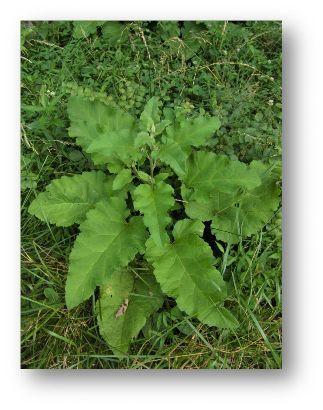
Burdock
Arctium Lappa, Arctium Minus
Burdock is best known for its giant, rhubarb-like leaves and round, sticky cockle-burs, said to have inspired the invention of Velcro (™). Often found growing in pastures, burs are nuisances that tangle themselves in the fur of livestock, and pets.
Burdock cockle-burs are round. The plant with oval cockle-burs is the unrelated Xanthium strumarium which is a toxic plant.
Burdock is one of the most utilized detoxifying herbs in both Chinese and Western herbal medicine. It is known as a “blood purifier” and tonic. Burdock Root is used medicinally as an infusion (tea), a tincture, and in herbal capsules as well as cooked as a vegetable.
Supplementation with Burdock root has shown positive effects in the treatment of acne especially of the inflammatory type. The oil from Burdock seeds has been shown to have anti-aging properties in skin care.
Burdock leaves can be used as a poultice or made into a herbal salve for irritated skin. They are said to be helpful with fever when laid across the forehead.
If you are patient enough to remove seeds from their sticky coatings, you could grind them very fine, add some Olive or another good oil, and use for an anti-aging, anti-acne body scrub. Use right away or store in your refrigerator no more than a few days. Oils tend to turn rancid fast when you add plant material that is not completely dry. Your scrub will last longer if the plant material is completely dry before infusing with the oil.
Burdock root is edible and use in Asian cooking where it is called “Gobo”. You can harvest the roots in their first autumn through early spring.
Use Burdock root as you would potatoes or slice them and add to stir-fry. Burdock leaves are delicious as a wrap for fired roasted meats with no other seasoning needed for flavor.
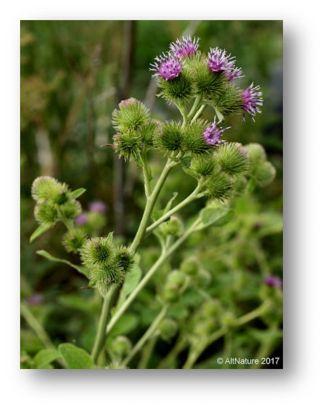
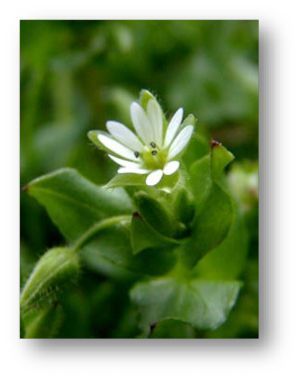
Chickweed
Stellaria Media
Chickweed appears in fall as green mats of sprawling little plants with opposite oval leaves, five deeply divided white petals that at first glance seem to grow in pairs. The spindly, sometimes pinkish colored stems have a line of hairs growing along one side. Chickweed gets its name from the fact that it is a favorite foraging plant for chickens. Many animals, including pet birds, enjoy the flowering tops and seeds of Chickweed. However, it is said that goats will not touch it!
An infusion - the herb steeped like tea, made from Chickweed is a good source of Vitamin C, iron, and phosphorus. It has been used for digestive disorders, sore throat, rheumatism and more. The infusion also has a reputation as a remedy for constipation, hoarseness and coughs.
Chickweed flowers and leaves can be eaten raw, dried for herb tea, made into a tincture, or infused in oil. The tincture and infused oil can be used as a liniment for sore muscles or irritated skin.
Chickweed juice is an excellent external herbal remedy for itching. It can also quickly stop bleeding and speed healing of minor wounds. Some people use Chickweed for the relief of eczema and psoriasis and claim it to be beneficial. It is commonly used in herbal salves for its reputed healing properties.
For home remedy use, freeze chickweed juice into ice cubes, then store them in zip lock bags for future use. You can also dry the herb or use fresh for tea or tincture. I freeze the whole herb fresh for summer use, which is about the only time I can't harvest it in the south. My chickweed grew like crazy in pots over the winter, even with snow and below freezing temperatures.
Chickweed tea is an old wife’s herbal remedy for obesity. A study concluded that an extract of Chickweed is beneficial in the suppression of hormone-induced obesity in rats. It has also shown to have antihistamine and anti-inflammatory as well as hepaprotective properties.

Chickweed can be eaten raw in salads or on sandwiches, cooked as a vegetable in soups, or simmered as a pot green. It can also be canned or blanched and frozen for future edible use. Enjoy Chickweed as a free substitute for Spinach as it tastes very similar.
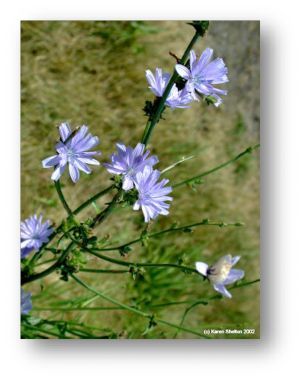
Chicory and Dandelions
Prior to flowering, Dandelion and Chicory leaves look very much alike. Both plants have deeply serrated leaf margins, with Chicory having the largest leaves. Chicory leaves vary in appearance and are easily mistaken for Wild Lettuce and Dandelion and may or may not be deeply toothed. Chicory sets forth tall stems that are hairy at the lower portion, with pretty light blue stalkless flowers and lance shaped leaves clasping the stem. Dandelion lays low with its common yellow flowers on smooth, naked stalks. Chicory leaves have fine hairs, especially noticeable on the underside of the leaf midvein. True Dandelion leaves and stems are hairless. Both plants have a white latex sap that seeps out when the stems are broken.
The plants are also similar in that juices from the leaves and herb tea of the flowering Chicory and Dandelion plants are known as herbal remedies for promoting the production of bile, the release of gallstones, and elimination of excessive internal mucus.
Both Chicory and Dandelion root can be chopped into small pieces and roasted, then used as a herbal coffee replacement, or added to coffee to and reduce digestive disturbances and jitters from caffeine.
Chicory
Cichorium intybus
Chicory is a common wildflower that likes rocky soil on roadsides, but just might show up in your yard as well. If not, you can easily grow this useful herb from seed. You will have to get out early to see Chicory flowers as they usually close by noon.
A herbal tea made from Chicory leaves and flowers has mild laxative and sedative properties. You can brew roasted and ground chicory with coffee or on its own for a coffee like beverage to enjoy its many health benefits. Luzianne ™ coffee is made with added chicory root to enhance its richness.

According to a study, Chicory root has a significant effect on abdominal obesity, related to the beneficial impacts of inulin on gut bacteria. A daily dose of inulin that promotes bifidobacteria growth, may improve gut function and is well tolerated by subjects with gastrointestinal complaints.
Research has shown that inulin from Chicory root may be beneficial for Type 2 diabetes mellitus, and yet another showed that Chicory roots possess anti-inflammatory activity which might be due to the inhibition of various cytokines, antioxidant effects, and their free radical scavenging activity.
A study of Chicory root extract showed protective and restructuring effects on the skin and improvement of skin barrier function. Boiled chicory leaves and flowers can be used in a poultice for external inflammations. Chicory root extract might be a good addition to homemade beauty products.
Chicory leaves can be used to produce a natura; blue dye, and the flower petals can be eaten in salad. The vegetable Endive is a hybrid of our wild chicory, grown in dark conditions to prevent the development of chlorophyll.
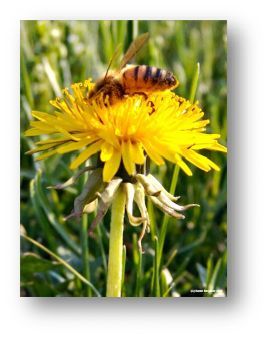
Dandelion
Taraxacum officinale
This sunny flower is much maligned as a weed but almost every part of this highly nutritious plant is valued in herbal medicine and can be used for food or healthful supplement to your diet.
Dandelion is used in teas and tinctures as a detoxifying tonic for the blood, liver, and gall bladder, and to ease minor digestive problems.
Dandelion leaf tea is considered a diuretic, but as it is high in potassium, it does not deplete potassium levels like medications tend to do. An infusion of Dandelion flowers was used by the Cherokee “to make a woman stronger after childbirth.”
Laboratory studies have shown dandelion to have anti-cancer properties, but clinical studies have not confirmed this effect in humans.
Dandelion can be made into a salve for the same conditions as Chicory. It is said that the sap from Dandelion stems can be used to fade age spots and remove warts. Avoid the stems if you are allergic to latex.
Dandelion leaves and flowering crowns are considered by some to be a spring delicacy and tonic food. The flowers can be dipped in batter and made into fritters. Some people enjoy a wine made from Dandelion flowers. Flower buds are steamed as a vegetable and the leaves are eaten as a salad green or cooked potherb.
“How empathic it is” A sun in the grass!” Thoreau
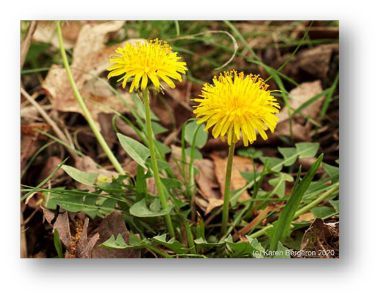
Children enjoy Dandelions immensely and there is hardly a better plant to use to introduce them to Nature’s wonders. Holding a flower under a friend’s chin somehow reflects yellow, and that in folklore means that they love butter. Kids love to blow the seeds in the wind, this is done to “make a wish.” If you split the stems and dip them in water, they will make Curly Q’s. Maybe the fun will even encourage them to try some cooked Dandelion greens, which are very high in Vitamin C, A, and potassium.
Excessive amounts of Dandelion were shown in a study to reduce male fertility in mice. So, guys, limit consumption of Dandelion if you want to father a child or boost your libido!

Cinquefoil
Potentilla capensis, Potentilla simplex
Cinquefoil has palmate divided, toothed leaves on long, thin, stems and small yellow flowers with five slightly notched petals. It is often found sprawling as a ground cover in part to full shade areas.
The genus name, Potentilla, means “powerful little one.” This is probably based on its strong, astringent propertie that come from the tannins in the plant.
An infusion of Cinquefoil leaves and flowers is said to be a good herbal remedy for diarrhea and looseness of the bowels, and for other complaints for which astringents are usually prescribed. It has also been used for PMS an menstrual related pains.
Cinquefoil infusion can be used as a tightening gargle for loose teeth, spongy gums, sore throat, and hoarseness. In an emergency, the herb could be crushed and made into a poultice to stop bleeding.
Cinquefoil is also used externally as an astringent lotion and a gentle wash for delicate skin. A study shows that Potentilla simplex demonstrates promising anti fungal potential. Cinquefoil is also an ingredient in many anti-wrinkle cosmetic preparations.

For the above uses, one ounce of Cinquefoil leaves and flowers are steeped in a pint of boiling water for a few hours then strained and taken in ½ cup doses up to 3 times a day, or to be used as a toning wash or gargle. You can store the mixture in the refrigerator up to 2 days.
For longer lasting storage, make a tincture (instructions are at the end of this article) and you can add a dropper full of tincture to ½ cup of water and use as you would the infusion.
Cinquefoil can be used as a substitute for Agrimony in herbal preparations.
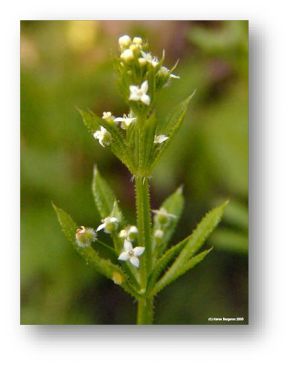
Cleavers
Galium Aparine
Cleavers gets its name from the stickiness of the whole plant. Whorls of narrow, lance-shaped, bristly, leaves grow on the sprawling, weak stems. The plant is covered with hairs that cleave to each other and for that matter, anything they touch. To make matters worse, the tiny white flowers develop into small burs that also bear the bristles.
Cleavers juice, tinctures, and infusions are said to be effective cleansers for the lymphatic system - a much gentler remedy than Pokeweed, but also much safer. It is also known as a remedy for stomach ulcers.
Cleavers infusion is made by macerating 1 ½ ounces of herb in a pint of warm water for 20 minutes and given in 2-4 oz. doses, 3-4 times a day. This is said to be helpful with all skin afflictions and will also fade freckles when taken for a few months. You may want to apply it to the skin, as well as taking internally. The same dose is supposed to be useful for bed-wetting in children.
Cleavers was once listed in the US Dispensary as a preventive and treatment for scurvy.

It is said that a balm made from Cleavers is used to heal irritated skin. However, some people get severe welts from harvesting Cleavers. Wear gloves and long sleeves when collecting and handling this plant. Strain teas, infused oils, and tinctures made from Cleavers to remove hairs before applying or ingesting to avoid irritation.
The roasted seeds of Cleavers are sometimes used as a coffee substitute in Sweden. They also use a mat of the plant to filter milk. This is said to give it additional health benefits.
Most of this genus is known by the name Bedstraw. Other species of Galiums have been traditionally used for anti-cancer, antioxidant, anti-inflammatory, antimicrobial and cardioprotective effects in folk medicine.

Dock
Rumex crispus
Known as Curly Dock, Narrow Leaf Dock or Yellow Dock, this plant will show up in the overgrown areas of yards with a hardy rosette of large leaves with wavy edges that botanical author John Eastman calls “resembling the lolling tongues of dogs.” The very young leaves and stems are edible but quickly turn bitter with age and are high in oxalic acid. The root, which has a radish-like taste and odor is used most frequently used in herbal medicine.
Dock has been used throughout the ages as a “blood purifier.” It was believed that its bitters cleansed the liver and eliminated toxins in the body.
A review confirms that some Rumex species have emerged as good sources of traditional medicine for treatment of inflammation, cancer, and different bacterial infections. Another study showed that a water extract of Rumex crispus may be effective against osteoporosis. An active compound found in Dock, nepodin, has antimalarial properties.
Dock is a good source for Thiamine, Vitamin C, and Iron. A poultice of Dock leaves or mashed root is used for ulcers, burns, skin diseases and was historically used for tumors and swellings.
A folk remedy saying, “Nettle in, Dock out,” was once famous as it told that rubbing Dock leaves would instantly ease the burn from Stinging Nettle.
Bitter Dock, Rumex obtusifolius, has broader leaves and the central rib is often reddish tinted. In research, an extract from Bitter Dock showed a significant effect on hyperglycemia, improving glucose tolerance, and increasing liver glycogen content. The extract reduced total cholesterol, LDL cholesterol levels, and vice versa increased HDL levels. It also decreased liver enzymes levels compared with the untreated group. The study shows that Bitter Dock may have beneficial effects as an herbal remedy in the treatment of Diabetes Mellitus.

An extract of the Dock seed has antioxidant properties. The ripened seeds are brown in late Summer and Fall. They can be ground to make a flour. Or why not try it for an exfoliating, antioxidant body scrub?
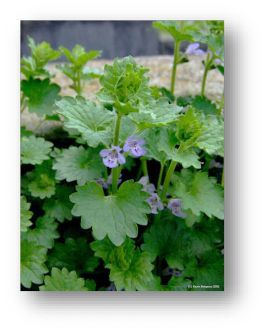
Ground Ivy, Creeping Charlie
Glechoma hederacea
Creeping Charlie gets little respect from those who prefer to keep a neat lawn and do not know of its many benefits. Although it is invasive, it may serve as a ground cover in places where the grass does not grow well, or at tree bases that are difficult to mow.
Also known as Ground ivy, a mass of small scallop-shaped evergreen leaves lays low on the ground for most of the year. At the flowering time in spring, it grows erect up to 6 inches to show off its dainty purple flowers nestled in the axils of its paired leaves, then returns to its ground-hugging habit.
The leaves and flowers of Creeping Charlie can be dried for tea, made into a tincture, and used externally in a salve or liniment.
An infusion of the above-ground plant is said by Lee Peterson, of Peterson’s Guides, “to make a fine tea.” It is supposed to be helpful for colds and lung ailments. Snuffing the fresh juice up the nose often helps nasal congestion and headache.
Ground Ivy has been used internally and externally for sciatica, hip gout, arthritic hands, and knees. Ground Ivy is also said to hasten early recovery of new wounds when applied as a poultice.
Herbalist Henriette Kress of Finland says of Ground Ivy “It's one of the few herbs that can touch noise- induced tinnitus…. I know because quite a few told me. It's 2-3 cups of tea for weeks or months on end, or until the noise stops. (... what a relief!)”
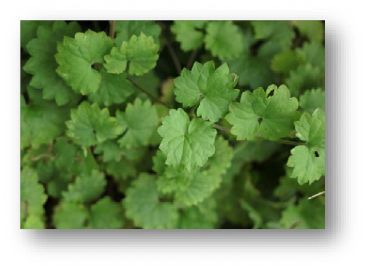
Ground Ivy is used in Italian spas as a bath soak for back pain, as well as its emollient and mild sedative properties. A 1986 study found that Ground Ivy’s ursolic and oleanolic acids protected mouse skin from induced tumor growth. It can also be used to lighten skin and fade age spots.
Before lead paint was banned, it was said that painters who drank Ground Ivy tea were not bothered with lead poisoning. Like most plants with edible leaves, it can be used as a flavoring, a spring green, or addition to soups and stews.
In the Middle Ages, Creeping Charlie was known as Ale-Hoof and was added to beer for flavor, to clarify, and add shelf life.
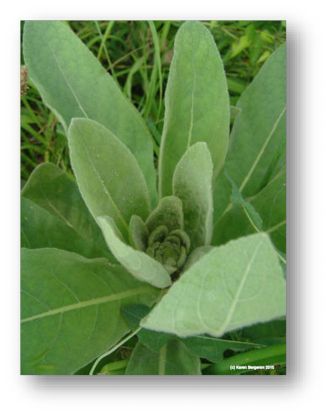
Mullein
Verbascum thapsus
Mullein first appears in late fall and winter as a somewhat large rosette of light green, fuzzy oval leaves that usually survive the coldest of winters. It can be found growing wild almost anywhere in sunny or part shade areas.
By late spring, a large flower stalk emerges from the center. In medieval times, the flower heads were dipped in wax and used as torches.
Mullein leaves can be harvested almost year-round from the time the rosettes appear in late fall, until it goes to seed in summer when the leaves will deteriorate.
Mullein flowers bloom a few at a time, so you can pick and set them to dry as they form. The flowers are soaked in olive oil for two weeks, then strained. You can use the infused oil for ear drops when there is pain in the ear or as a rub for sore muscles.
Mullein leaves are best known in herbal medicine as a remedy for relieving coughs. It is also said to have anti-bacterial and pain-relieving properties.
Mullein leaves are usually taken as an infusion but a tincture may also be used. When making a tincture with mullein leaves, use half as much dried herb as you would most plants. The dried leaves of Mullein swell more than most alcohol due to their bulk from the fuzziness of the plant. The leaves will blacken if they swell and don’t stay completely covered with alcohol. Whichever method you might use, be sure to strain the mixture so the little hairs don’t get caught it your throat.
Mullein leaves and flowers can also be incorporated into a home-made cough syrup (see syrup recipe on the Violets page.) Some people choose to smoke the leaves to relieve congestions, but perhaps putting some in hot water and inhaling the steam might be a healthier option.
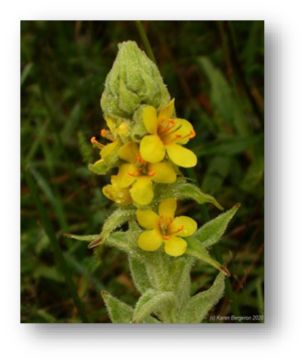
If you are really in a bind, Mullein’s soft fuzzy leaves are said be a substitute for toilet paper, however some say it can be irritating. The leaves close to the center are much softer than the rough, older leaves.
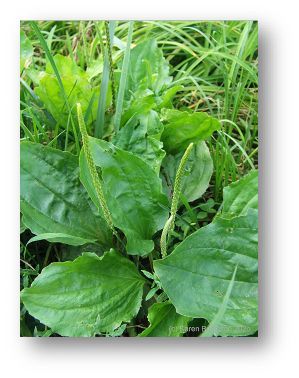
Plantain
Plantago major, Plantago lanceolata
Plantain is so common that the Native Americans called it “White Man’s Footprint” because they said it grew everywhere the settlers stepped.”
Plantain has distinguishing parallel, ribbed veins that run from the base of the stem to the tips of the leaves which are spoon-shaped (major) or narrow (lanceolata) and grow in a rosette. When not mowed, the flower spikes up to 12 inches tall.
Plantain easy to identify and familiar to almost everyone because it is so common in yards, but few know that the whole plant is edible as well as medicinal and is a good source of nutrition.
Plantain extracts have antibacterial properties. Juice from the crushed or chewed leaves quickly stops blood flow from wounds and encourages the repair of damaged tissue. A recent study showed that a 50% concentration of Plantain was helpful for burn wound healing and compared favorably to silver sulfadiazine and may be a suitable substitute. (Amini, et al., 2010)
Plantain is said to cause a natural aversion to tobacco and is used in smoking cessation preparations. Developing evidence suggests that plantain might help chronic bronchitis, making it a suitable addition to homemade cough syrups. Plantain infusion is approved by German Commission E for respiratory inflammations and catarrhs, as well as inflammatory reactions of the skin.
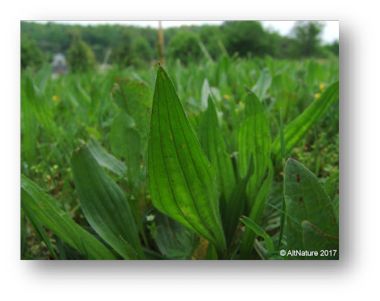
Plantain tea may be especially helpful with stomach ulcers.
Poultices and salves are made with Plantain to treat burns, insect bites, stings, and rashes.
The leaves are used in tea, tincture, or ground in capsules. The seeds may have cholesterol- lowering properties due to their fiber and mucilage content.
To use plantain, make a tincture or simmer a handful of leaves (or 2 tablespoons dried) for 10 – 15 minutes. Drink ½ cup as often as you like or use the leaves for a compress or poultice. The dried leaves can be infused in oil to make salves and balms. Plantain infused oil is even suggested to help reduce wrinkles!
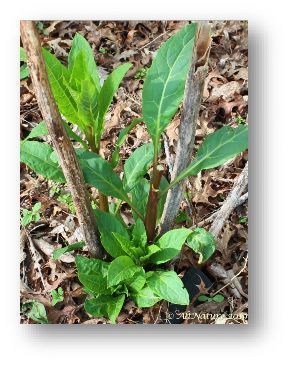
Pokeweed
Phytolacca Americana
“Tonic or Toxic? It’s in the Dose.”
Pokeweed is a hard plant to miss with its tall bright red stems and showy berries that hang in bundles like grapes in late summer. The young leafy shoots are one of the first plants up in spring. In the South, they are considered a spring tonic food. Due to their toxicity, they are boiled in two changes of water and usually cooked with fatback or butter before eaten. It is recommended to wear gloves when handling Pokeweed.
The Pokeweed plant is considered toxic once the stems turn red in the spring and the plant exceeds 6 inches in height. Ifyou have this plant on your property, teach your children to avoid the plant and its attractive berries.
Poke root and berries have medicinal uses as a potent detoxifying herb. It is used in minute doses compared to most other medicinal plants. Tinctures of Pokeweed root are used the advice of the most experienced herbalists - for cancer and detoxification. It is said to be very cleansing to the lymph system and almost every organ involved in elimination.
At doses of 1 g, dried pokeweed root is emetic and purgative - which means it forcefully purges everything through every bodily orifice in a most unpleasant way. At lower doses of 60 to 100 mg/day, the root and berries have been used to treat rheumatism and for immune stimulation; however, there are no clinical trials that support these uses or doses. It is said that swallowing one whole dried berry a day is useful for arthritis.
Large doses can cause diarrhea and vomiting, as well as skin irritation. Pokeweed should never be used by pregnant women.
A poultice made of the sun-dried berries and glycerin has been used for mastitis, though skin reactions may occur. However, some people have reported that a salve made from Poke root is helpful with irritating skin conditions.
Pokeweed antiviral protein shows clinical potential as a safe, barrier antiviral agent and for therapies for patients harboring highly drug-resistant strains of HIV-1.
Beautiful red ink and a dye are obtained from Pokeberries, but the color fades on cloth no matter what the mordant used. The juice from the berries is also used in small amounts to add color to canned goods.
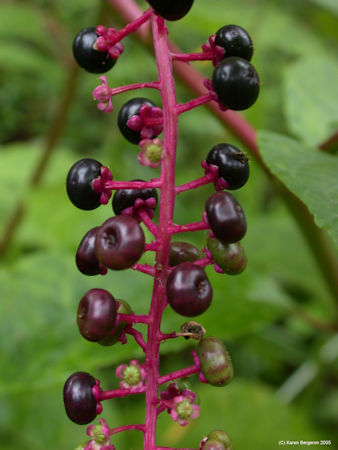
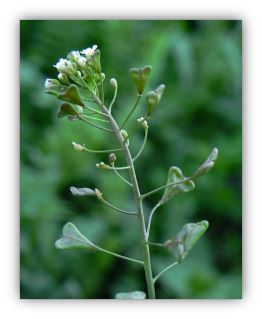
Shepherd’s Purse
Capsella bursa-pastoris
Shepherd’s Purse is found abundantly in spring all over the United States, forming large patches in waste grounds. The basal leaves are small and pinnately lobed, and often enjoyed in the spring as greens and accenting salad with their peppery taste. By late spring the stem dies, and the weed entirely disappears by the middle of summer.
Shepherd’s Purse plant has hemostatic properties. It is used to stop bleeding from internal organs and control profuse menstruation. It may be useful as a remedy for endometriosis.
For these uses, Shepherd’s Purse is best tinctured immediately after picking. As a decoction, it has been used to treat hemorrhoids, diarrhea, and bloody urine.
Warning : Shepherd's Purse may be sedating or toxic if overused or used with some prescription medications or anesthesia. Use with caution.
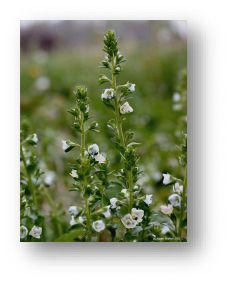
Speedwell
Veronica spp.
Speedwell was once a highly regarded in England as a healthy, relaxing, herbal tea and tonic. As with most astringent, bitter herbs, an infusion of speedwell can be used as a wash for troubled skin. It is most often used been used for coughs and congestion.
Recent studies have shown Speedwell tea may be an effective preventative treatment for ulcers.
The somewhat bitter and astringent taste and smell of speedwell led to its use as a tea substitute in 19th-century France, where it was called the d’Europe, or "Europe tea." The French still use this term as a name for speedwell. Emperor Charles, the Fifth of Spain, is said to have derived much relief to his gout from the use of this herb. It contains tannin and a particular bitter principle.
Use 1-2 tsp dried herb per cup of hot water for a tea, or use a tincture. Mix with plantain to ease pain from ulcers.
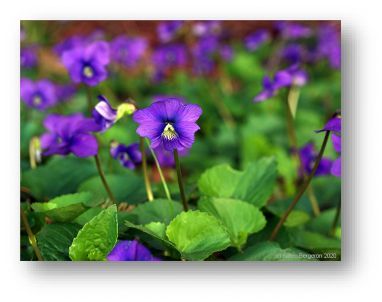
Violets
Viola spp.
Our most common Violets have heart- shaped, deep green leaves with purple, white, or yellow flowers. Although they add color to early spring yards, common Violets are sometimes considered a pain in the landscape because of their tendency to take over large areas.
The flowers and leaves of Violet can be made into a syrup used as an herbal remedy mainly for respiratory ailments associated withcongestion, coughing, and sore throats.
A decoction made from Violet root (dry herb) is used as a laxative. Tea made from the entire Violet plant is used to treat digestive disorders.

New research has detected the presence of a glycoside of salicylic acid (natural aspirin) which validates Violet's herbal use for centuries as a medicinal remedy for headache, body pains and as a sedative.
Violets are also used externally. The freshly crushed leaves reduce swelling and soothe irritations. As a bath additive, the fresh crushed flowers are soothing to the skin, and the aroma is very relaxing.
Violet flowers and leaves are edible and used as food additives - for instance in a salad, made into jelly, and candied for decoration. You can find several recipes for violets online.
Warning: Large doses of Violet root contain an alkaloid called violine which is emetic (causing vomiting).
Now that you have been introduced to some medicinal plants that most likely are growing near you right now, how will you use them? Here are some easy harvesting and preparation instructions to help you get started.



